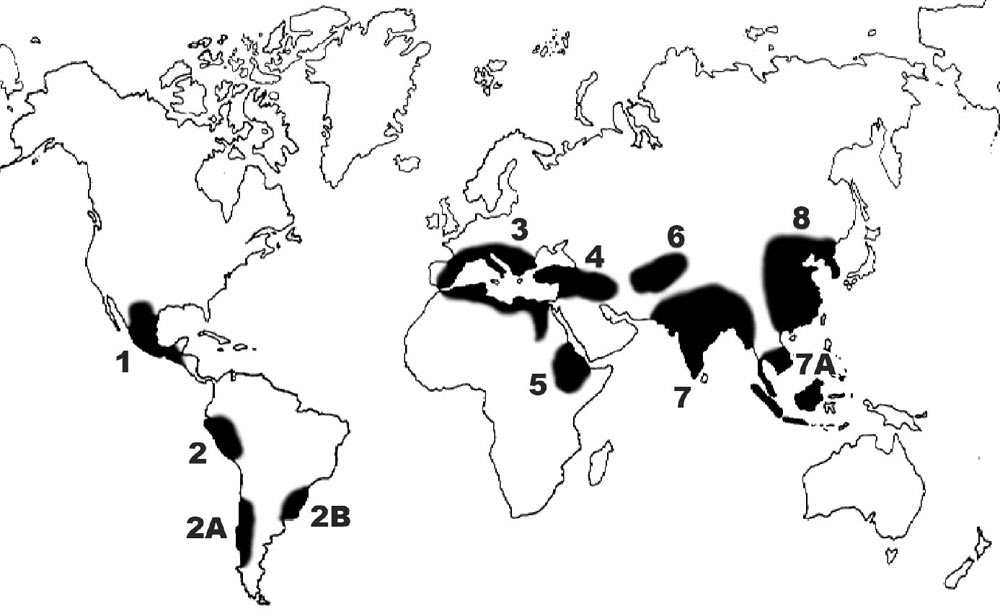Center of diversity on:
[Wikipedia]
[Google]
[Amazon]
 A center of origin is a geographical area where a group of organisms, either domesticated or wild, first developed its distinctive properties. They are also considered centers of diversity. Centers of origin were first identified in 1924 by
A center of origin is a geographical area where a group of organisms, either domesticated or wild, first developed its distinctive properties. They are also considered centers of diversity. Centers of origin were first identified in 1924 by
 A Vavilov Center (of Diversity) is a region of the world. First indicated by
A Vavilov Center (of Diversity) is a region of the world. First indicated by
 A center of origin is a geographical area where a group of organisms, either domesticated or wild, first developed its distinctive properties. They are also considered centers of diversity. Centers of origin were first identified in 1924 by
A center of origin is a geographical area where a group of organisms, either domesticated or wild, first developed its distinctive properties. They are also considered centers of diversity. Centers of origin were first identified in 1924 by Nikolai Vavilov
Nikolai Ivanovich Vavilov ( rus, Никола́й Ива́нович Вави́лов, p=nʲɪkɐˈlaj ɪˈvanəvʲɪtɕ vɐˈvʲiləf, a=Ru-Nikolay_Ivanovich_Vavilov.ogg; – 26 January 1943) was a Russian and Soviet agronomist, botanist ...
.
Plants
Locating the origin of crop plants is basic toplant breeding
Plant breeding is the science of changing the traits of plants in order to produce desired characteristics. It has been used to improve the quality of nutrition in products for humans and animals. The goals of plant breeding are to produce cr ...
. This allows one to locate wild relatives, related species, and new genes (especially dominant genes
In biology, the word gene (from , ; "...Wilhelm Johannsen coined the word gene to describe the Mendelian units of heredity..." meaning ''generation'' or ''birth'' or ''gender'') can have several different meanings. The Mendelian gene is a ba ...
, which may provide resistance to diseases).
Knowledge of the origins of crop plants is important in order to avoid genetic erosion
Genetic erosion (also known as genetic depletion) is a process where the limited gene pool of an endangered species diminishes even more when reproductive individuals die off before reproducing with others in their endangered low population. The ...
, the loss of germplasm due to the loss of ecotypes and landraces, loss of habitat
Habitat destruction (also termed habitat loss and habitat reduction) is the process by which a natural habitat becomes incapable of supporting its native species. The organisms that previously inhabited the site are displaced or dead, thereby ...
(such as rainforests), and increased urbanization. Germplasm preservation is accomplished through gene banks
Eugene Lavon Banks (born May 15, 1959) is an American former professional basketball player. He was born and raised in Philadelphia.
High School Career and College Recruitment
A 6'7" forward, Banks attended high school in West Philadelphia. Ni ...
(largely seed collections but now frozen stem sections) and preservation of natural habitats (especially in centers of origin).
Vavilov centers
Nikolai Vavilov
Nikolai Ivanovich Vavilov ( rus, Никола́й Ива́нович Вави́лов, p=nʲɪkɐˈlaj ɪˈvanəvʲɪtɕ vɐˈvʲiləf, a=Ru-Nikolay_Ivanovich_Vavilov.ogg; – 26 January 1943) was a Russian and Soviet agronomist, botanist ...
to be an original center for the domestication of plants. For crop plants, Nikolai Vavilov
Nikolai Ivanovich Vavilov ( rus, Никола́й Ива́нович Вави́лов, p=nʲɪkɐˈlaj ɪˈvanəvʲɪtɕ vɐˈvʲiləf, a=Ru-Nikolay_Ivanovich_Vavilov.ogg; – 26 January 1943) was a Russian and Soviet agronomist, botanist ...
identified differing numbers of centers: three in 1924, five in 1926, six in 1929, seven in 1931, eight in 1935 and reduced to seven again in 1940.
Vavilov argued that plants were not domesticated somewhere in the world at random, but that there were regions where domestication started. The center of origin is also considered the center of diversity.
Vavilov's scheme as updated by Schery and Janick
Vavilov centers are regions where a high diversity ofcrop wild relative
A crop wild relative (CWR) is a wild plant closely related to a domesticated plant. It may be a wild ancestor of the domesticated (cultivated) plant or another closely related taxon.
Overview
The wild relatives of crop plants constitute an i ...
s can be found, representing the natural relatives of domesticated crop plants.
Cultivated plants of eight world centers of origin History of Horticulture, Jules Janick, Purdue University, 2002
Purugganan and Fuller 2009 scheme
See also
*Crop wild relative
A crop wild relative (CWR) is a wild plant closely related to a domesticated plant. It may be a wild ancestor of the domesticated (cultivated) plant or another closely related taxon.
Overview
The wild relatives of crop plants constitute an i ...
*Crop diversity
Crop diversity or crop biodiversity is the variety and variability of crops, plants used in agriculture, including their genetic and phenotypic characteristics. It is a subset of and a specific element of agricultural biodiversity. Over the pas ...
*Landrace
A landrace is a domesticated, locally adapted, often traditional variety of a species of animal or plant that has developed over time, through adaptation to its natural and cultural environment of agriculture and pastoralism, and due to isolatio ...
* Neglected and underutilized crop
References
{{DEFAULTSORT:Center Of Origin Conservation biology History of agriculture Neolithic